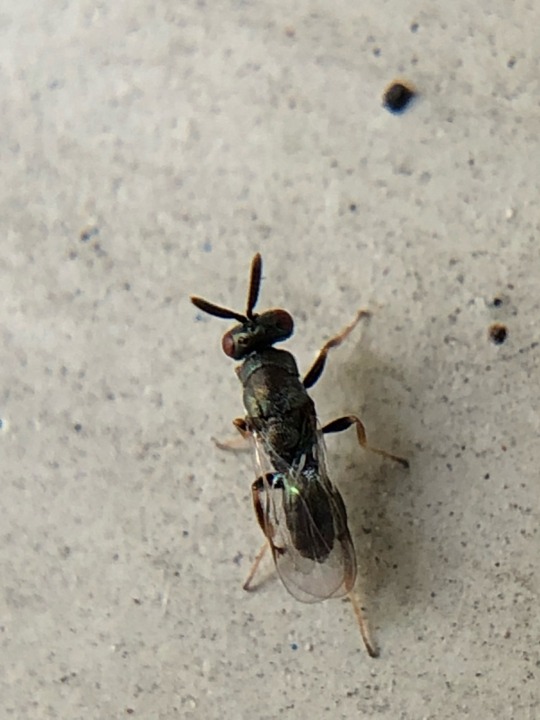#Ichneumonoidea
Text


Drawing of the day: Megarhyssa greenei. Bonus mini collage of my favourite non-cartoon wasp drawings. I plan on adding more as I go along. For now, this is only a sample. Drawing wasps is keeping me sane during these dark times. Which one is your favourite?
#hymenoptera#insect#entomology#wasp#wasps#apocrita#aculeata#vespoidea#vespidae#vespinae#Vespulaintermedia#Ichneumonoidea#Ichneumonidae#Rhyssinae#Megarhyssagreenei#Apoidea#Sphecidae#Sphexlatreillei#Chrysidoidea#Chrysididae#Chrysidinae#Chrysisequestris#illustration#traditionalart
1K notes
·
View notes
Text
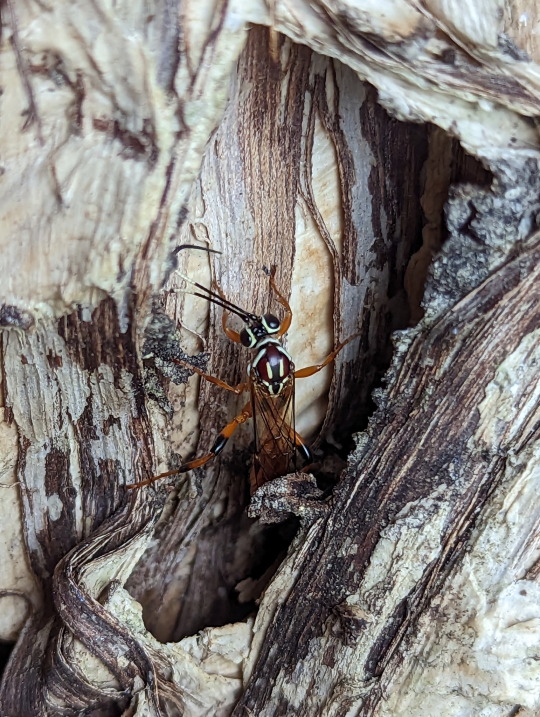
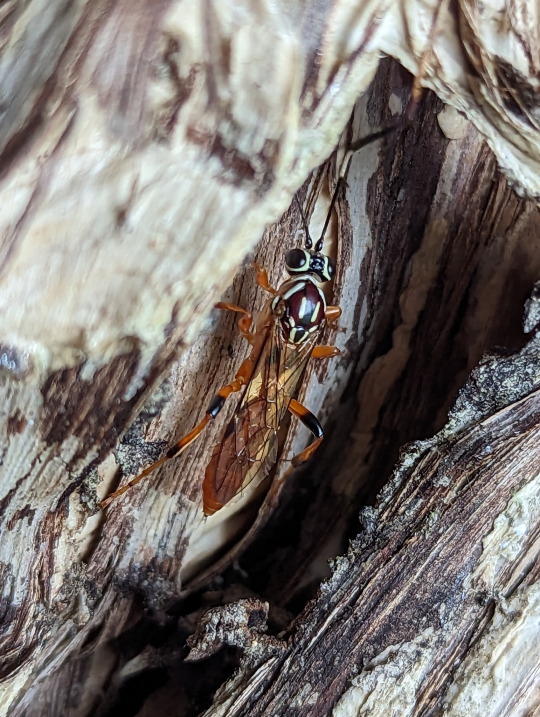
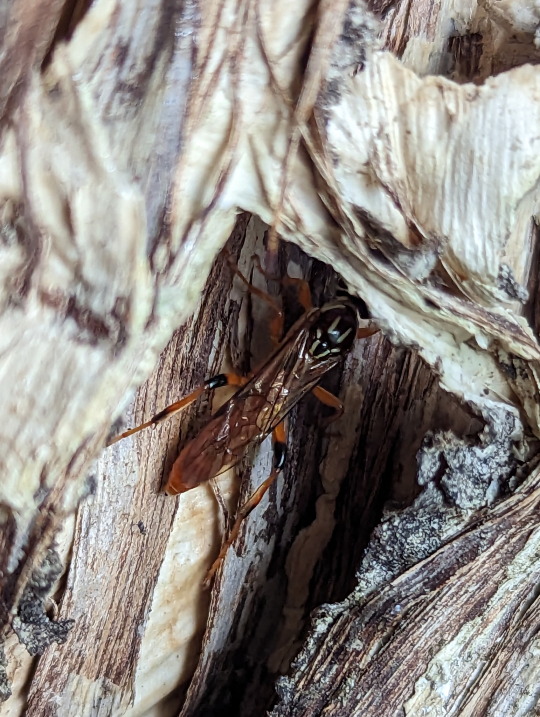

Large Wasp
Unidentified, superfamily Ichneumonoidea
22/03/23
#Ichneumonoidea#Wasps#Hymenoptera#unidentified#invertblr#invertebrates#Arthropods#Arthropoda#bugs#bugblr#bugs tw#insects#insecta#insectblr#entomology
27 notes
·
View notes
Text
Animal practice 37

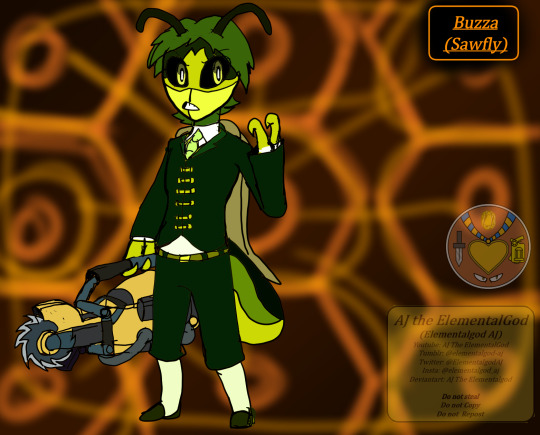

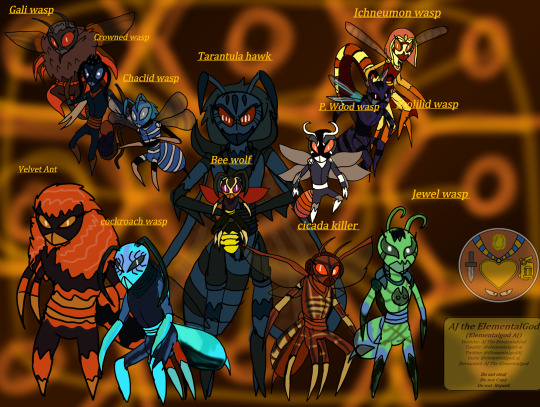


Panarthropoda
Arthropoda 4
Hexapod 4
Hymenoptera 1
Emorossa (Ant/Bee/wasp/termite hybrid)
Symphyta
Buzza (sawfly)
Wild wasps
Crimson the abominable (wild wasp)
Orussoidea
Parasitoid wood wasp
Stephanoidea
Crowned wasp
Ichneumonoidea
Ichneumon wasp
Cynipoidea
Gall wasp
Chalcidoidea
Chalcid wasp
Chrysididae
Jeweled wasp
Mutillidae
Velvet ant
Pompiliidae
Spider wasp/Tarantula hawk
Scoliidae
Scoliid wasp
Ampulicidae
Cockroach wasp
Crabronidae
Cicada killer
Beewolf
#the watchful eye#watchful eye#my oc#my ocs#my art#elementalgod aj#aj the elementalgod#isle 0#toonverse oc#o'kong family#neo demons#earthdemons#anthro allies#panarthropoda#arthropods#hexapods#insects#Hymenoptera#sawfly#wild wasps#spider wasp#velvet ant#cicada killers#beewolf#cockroach wasp#jeweled wasp#ichneumonid wasp#bees#ants#wasps
4 notes
·
View notes
Text
Fwd: Graduate position: UCentralFlorida.ComparativeGenomics
Begin forwarded message:
> From: [email protected]
> Subject: Graduate position: UCentralFlorida.ComparativeGenomics
> Date: 12 October 2023 at 05:16:29 BST
> To: [email protected]
>
>
>
> The Sharanowski lab at the University of Central Florida is seeking
> a Ph.D. student to work on comparative genomics and evolutionary
> genomics projects, focusing on parasitic wasps in the superfamily
> Ichneumonoidea. This research will be largely computational and thus a
> strong background in programming would be ideal, as well as course work
> in genomics, genetics, and several courses that would provide a strong
> quantitative background. Students with a biology, math, or a computer
> science degree are highly encouraged. Students with Masters degrees are
> preferred but not required.
>
> PhD students are supported via graduate teaching assistantship
> from the Biology Department and are supplemented with summer salary
> from the Sharanowski Lab for full support including health insurance
> benefits. Interested applicants are encouraged to email Dr. Sharanowski
> by November 15th with a
>
> a CV outlining research experience with 3 names of references includeda
> copy of current transcripts (covering at least the past 2 years)and a
> short description of research interests including why you want to join
> the Sharanowski Lab.
>
> Dr. Sharanowski will contact suitable applicants for a zoom interview to
> assess fit. Applications to UCF are due Dec 1st, 2023. International
> applicants are welcome. The University of Central Florida is a large
> university and a designated Hispanic serving institution. Students
> from all backgrounds are encouraged to apply. Orlando is a diverse
> and beautiful city and the department, campus and city have supportive
> communities.
>
> Dr. Barb Sharanowski
>
> Associate Professor,
> Department of Biology
>
> University of Central Florida
>
> barb.sharanowski [at] ucf.edu
>
>
> Barbara Sharanowski
1 note
·
View note
Text
hi friends and mutuals check out my insect blog @ichneumonoidea. its a canon bug url and everything
0 notes
Photo


These two may be related!
Not in a familial sense, no. These are related in the sense that there may be something that they both have in common! Butterfly larvae!
Let me explain. I had noticed that the red Ichneumonoidea wasp seemed to hang around the same tree a lot. Every time I was there, it was there and protecting the tree with gusto! It has chased me off after I tried photographing it and this is the best I have of it. So I took note of the fact that it seemed to be REALLY attached to this tree.
Yesterday, while looking at jumping spiders, I noticed this ant that looked like a beautiful jewel climbing this tree… then another. It seemed that they had created a nest in the tree that extended up the entire trunk. The wasp was very eagerly hanging out at the nest that these beautiful green ants (Rhytidoponera metallica) had established.
“So how are these related?” You wonder? Well, upon trying to find out what the wasp was, I discovered that it likes to lay its larvae in one chosen species or similar, larvae from certain butterflies. A type of caterpillar that pretends that it is an ant larvae and gets taken care of by a nest. They’ve been known to make noises similar to the queen ant to be protected by the nest, smell like an ant, eat the ant larvae and even get protection from the ants as it leaves the nest when it becomes a butterfly.
Initially, upon reading it, I thought that it may have been a larvae from the Phengaris Rebeli or similar, which are endangered, but I could only find articles about them being adopted by the Myrmica ants and not the green ants.
One article was written by a professor at a university and I asked him about it and he said that it was possible, considering the unknown that comes with bugs and thought that the question I’d asked was very interesting. While he did not know for sure, he did send me a link to a page about the Lycaenid butterflies, and they too get looked after by the ants by providing a substance for the ants, like a sort of bribe.
So now I have questions because while the Phengaris get adopted INTO the nest to be looked after in the nursery, the Lycaenid stays on the outside of the nest and pupates there. The wasp was hovering around the nest as if there was something inside which makes me think that it is a larvae that gets adopted. I have seen the Lycaenid pupae around on the same property though… I am still reading up on all of this as it is very interesting!
Or I am mega-wrong and it just likes ants or the ants share a space with an entirely unrelated insect that the wasp is after… Either way, I learned all about butterflies whose larvae manipulate ants and the predators that hunt them and I learned about an endangered species! Secretly, I kind of hope that if there is a Phengaris in that nest, that it is a sign that they get adopted by the green ants too and that could be vital information that’d be beneficial to its protection! How exciting could that be! It is all just a big guess as this stage though…
I will be keeping a very close eye on the nest!
FUN FACT: The long, black “stinger”-looking things on the ends of its tail has no sting, but it is used to reach into wood or folded leaves to reach the prey that it will lay its larvae into.
Found on the NSW Far South Coast, Eurobodalla region.
#Green ant#Ichneumonoidea#wasp#entomology#amateur entomology#photography#endangered species#phengaris#lepidoptera#ants#wasps#nature#nature photography#parasite#lycaenid#theory#nikon#nikon photography#nikon d3200
108 notes
·
View notes
Photo

Ophion wasp (by me)
#Ophion#Ophioninae#Ichneumonidae#Ichneumonoidea#Parasitica#Apocrita#Hymenoptera#Insecta#Hexapoda#Arthropoda#parasitic wasp#wasp#insects#spring#Highland Park#Middlesex County#New Jersey#mine
13 notes
·
View notes
Note
top 5 wasps for the ask game?
youve activated my mental disorders
Im just gonna go by family here
1. Ichneumon wasps! they are an extremely diverse family of wasps and just really fascinating to learn about overall. Their methods of parasitism are also p diverse but the vast majority are parasitoids and there’s also a hyperparasitoid subfamily that lays their eggs in the eggs of other ichneumon wasps. It also is the family that 2 of my favorite species come from (Megarhyssa atrata which has the longest ovipositer of any insect! it uses it to parasitize wood wasps! & Megarhyssa macrurus)
2. Mymaridae - family of chalcid wasp that has some of the smallest insects recorded (including THE smallest insect- the blind wingless male of the species Dicopomorpha echmepterygis) I only got interested in them fairly recently but they are so cool. i am looking
3. Vespidae. A classic. how can I deny the wonders of the social wasp? Special shoutout to potter wasps + four toothed mason wasps for being very pretty and usually letting me pick them up. also I love their nests
4. Cuckoo wasps! they are very gorgeous and brood parasitism/kleptoparasitism are both very interesting mechanics of parasitism imo they have a lot of interesting adaptations wrt chemical signals etc in order to lay their eggs
5. Braconid wasps! very closely related to ichneumon wasps. theyre in the same superfamily (Ichneumonoidea) and another extremely diverse group of parasitoids. Fun fact ichneumon and braconid wasps both have their own strain of polydnavirus (Ichnoviruses and Bracoviruses respectively) that live in the ovary of female wasps and enter the hosts when the egg is laid inside and it supresses the hosts immune system so the egg isnt suffocated by white blood cells. Theres evidence that the wasps and the virus have been related since more than 70 million years ago. how neat
3 notes
·
View notes
Photo

Yet another late Bugtober fill -- last one for the day!
Day 29: Wasp (from @saturniidays 2018 list)
Megarhyssa rixator, a large ichneumon wasp. Like the majority of Ichneumonoidea, it is a solitary, parasitoid species. Its larvae feed on the larvae of horntail wasps, ultimately killing them. The female possesses a long ovipositor, which allows it to bore through wood and lay eggs on the host. When not in use, the ovipositor is stored in a flexible pouch in its abdomen. Despite its intimidating size, it is incapable of stinging and is harmless to humans.
29 notes
·
View notes
Text
**Edit** It's FINISHED! :) An Ichneumonid genus of each subfamily! Keep in mind that there are THOUSANDS (if not more) species of Ichneumonid wasps, including those we haven't yet discovered, and extinct ones. There are many, many genera as well, but I picked one for each subfamily. Obviously, morphology is very diverse within a subfamily, so these characters don't represent the subfamily as a whole, but are genera that occur within their designated subfamilies. You can have two Ichneumonid genera/species from the same subfamily that look substantially different morphologically.

Idiogramma (Tryphoninae)
Diplazon (Diplazontinae)
Amblyjoppa (Ichneumoninae)
Campoplex (Campopleginae)
Therion (Anomaloninae)
Euceros (Eucerotinae)
Theronia (Pimplinae)
Metopius (Metopiinae)
Opheltes (Ctenopelmatinae)
Odontocolon (Xoridinae)
Coleocentrus (Acaenitinae)
Orthocentrus (Orthocentrinae)
Echthrus (Cryptinae)
Chriodes (Nesomesochorinae)
Melanodolius (Sisyrostolinae)
Oxytorus (Oxytorinae)
Banchus (Banchinae)
Hyperacmus (Cylloceriinae)
Megarhyssa (Rhyssinae)
Podoschistus (Poemeniinae)
Hybrizon (Hybrizontinae)
Arotrephes (Phygadeuontinae)
Lycorina (Lycorininae)
Lepidura (Mesochorinae)
Enicospilus (Ophioninae)
Probles (Tersilochinae)
Diacritus (Diacritinae)
Collyria (Collyriinae)
Labena (Labeninae)
Brachycyrtus (Brachycyrtinae)
Alomya (Alomyinae)
Tatogaster (Tatogastrinae)
Ateleute (Ateleutinae)
Microleptes (Microleptinae)
Pedunculus (Pedunculinae)
Clasis (Claseinae)
#hymenoptera#insect#entomology#wasp#wasps#apocrita#parasitica#Ichneumonoidea#Ichneumonidae#IchneumonidSubfamilies#cartoon#comic#chart
716 notes
·
View notes
Text

Not all the Asian magpie moth caterpillars will survive.
Of course, without these parasites the caterpillars would quickly overtake our planet. It's a horrible form of natural pest control.
04/07/23 - Hymenoptera: Ichneumonoidea sp., host: Nyctemera baulus
QLD:WET - farmland
#invertblr#invertebrates#Arthropods#Arthropoda#insect#insectblr#insecta#insects#insects tw#bugs#bugblr#bugs tw#bug#entomology#dead tw#death tw#parasites tw#Nyctemera baulus#Ichneumonoidea#hymenoptera#unidentified#parasitism#cocoons & cases#structures#pupae
10 notes
·
View notes
Text
Netelia testacea - Lumci/Ichneumonoidea
youtube
Toto video jsem natočil 9.5.2017 chvíli potom, co jsem potkal stádo muflonů, o kterém jsem psal ve svém minulém příspěvku.
Na první pohled jsem tohoto zástupce hmyzu nebyl schopný identifikovat (hmyz není zrovna moje nejoblíbenější část živočišné říše), ale věděl jsem, že už jsem ho, nebo něco jemu podobného, už někdy předtím viděl. Identifikace byla poměrně snadná, protože velkého létajícího hmyzu zabarveného do červena asi není zvlášť velké množství (minimálně v ČR).
Při hledání údajů o tomto hmyzu jsem se dozvěděl docela zajímavou historku s Charlesem Darwinem. Tento hmyz totiž klade svá vajíčka přímo do živých housenek a vyklubané larvy je potom doslova sežerou zaživa. Charles Darwin byl údajně tímto aktem tak znechucen, že začal pochybovat o existenci milosrdného a všemohoucího boha :).
#netelia#testacea#lumci#Ichneumonoidea#Ichneumonoidae#big#large#long#red#insect#flying#velký#červený#létající#hmyz#vosa#wasp#oranžový#oranžová#orange#video
0 notes
Note
When I were a lad I had the unfortunate luck to sit on on a yellow jacket nest, step on another a week later and then a hornet nest a week later. I developed a phobia and now my heart races even if a fly buzzes past my ear. I have done some emersion therapy by walking in a lavender field while honey bees were working.. but I still fear bee-ish creatures. I love them and I plant them flowers, but I want to be less afraid. What can I do?
Hello, @keepcalmandcarrieunderwood, I’ve been thinking about your question a lot, and this is a really hard one to answer. The obvious first step in getting over a fear of anything is wanting to get over that fear. When you have so many traumatic experiences so close together, especially when you’re young, it will take a lot of work to train your mind to be more comfortable around black and yellow striped things. So first off, congratulations on wanting to be more comfortable about our stripey friends! The good news is, you can do it!
Warning: wall of text precedes bug photos! Also this got Looooooong sorry (not sorry)
Fun fact about me: I have a Bachelor’s degree in Psychology (from way back in 2005). And one of my favorite things about studying psychology was learning about classical and operant conditioning. You are probably already familiar with both of these.
In classical conditioning, two stimuli are paired (they may or may not be at all related), and your reflexive, unconscious response to one gets associated to the other. This phenomenon was popularized with Pavlov and his digestive experiments with dogs (dogs salivate when a bell rings in the absence of food, because the bell has been paired with food many times previously). In your case, the two stimuli are actually very closely related (seeing/hearing things that might be stinging insects, and being stung by stinging insects). Because many organisms rely on learning quickly about danger for survival, it can only take one such pairing to develop a very long-lasting response to something.
In operant conditioning, behaviors are punished or rewarded, which can result in an individual’s behavior changing given the right circumstances. The behavior change is not necessarily conscious. A lot of interesting stuff in our brains happens outside of view from us. Say you look into a cactus flower once and you see a really cool beetle. Neat! You’re going to start looking into cactus flowers a lot more often. And if you keep seeing neat beetles, oh boy those cactus flowers better look out. Even if those flowers start turning up empty, you’ll still keep peeking in them for a while, even if you are in a situation where it’s really not appropriate to keep peeking into cactus flowers (apologies to people on my last guided hike…). I’ll get back to operant conditioning in a minute.
You may have heard about a common treatment for anxiety disorders called Cognitive Behavioral Therapy. I’m a big fan of this method, because it asks you to re-evaluate your thoughts, as you are having them, to restructure your gut reaction to a situation into a less emotionally-charged one. In other words, you have a fear resulting from classical conditioning–it’s totally reflexive and unconscious, and you had no control over the creation of your phobia. The problem is, phobias can become self-sustaining with the help of operant conditioning. Basically: Bee > PANIC! > flee > relief! The act of removing yourself from bee-like insects will give you relief from the fear, and makes you more likely to avoid bee-like insects in the future. But, you don’t want to be afraid anymore!
The trick is: turn your reflexive, unconscious responses into thoughts. This can be really hard–I have a lot of generalized anxiety issues, and I don’t always know what (if any) actual thoughts are making me uneasy. But I think it is easier to translate reflexes into thoughts for phobias, even if they aren’t always logical.
In the case of a fear of stings from bees/wasps, there are several angles you can take:
Learn more about stinging insects and their behaviors, and understand why they sting. Take fear and reshape it into curiosity, use what you learn to avoid getting stung.
Not all that buzzes is a bee. Similarly for yellow/black striped insects. There are lots of mimics out there, who look like a dangerous stinging insect to protect themselves, when they are totally harmless. Learn how to tell them apart, so know which ones couldn’t hurt you even if they wanted to.
Not all bees/wasps can sting! Males cannot sting, and some species are completely stingless.
Desensitization through Education
First off, you need to know a little about stingers. What are they, exactly? Well, they weren’t originally stingers. Before there were stingers, there were ovipositors.

Ovipositors in katydids. Left two: common conehead katydids; Right: lesser meadow katydid
Ovipositors are tubes that some insects use to lay their eggs inside something. Insects who lay their eggs in the ground (but who aren’t burrowing insects, like katydids) will use the ovipositor to make sure the eggs are safely tucked away from predators. Some insects go a step further, and lay their eggs inside another organism (these are called parasites or parasitoids depending on whether or not they kill the host). These insects will lay their eggs either in plant tissues (gall wasps and midges do this, and I wrote a post about galls a little while back [link]), or in animal tissues.

Various parasitic wasps, Superfamily Ichneumonoidea. I have no idea who these are at the moment. iNat links: [Photo 1 Link] [Photo 2 Link] [Photo 3 Link]
These parasitoid insects tend to be wasps, and they tend to have some pretty fancy ovipositors. The larger ones tend to parasitize caterpillars, and before you gasp and lament the plight of the poor helpless babies, remember that every living creature in nature serves a very important purpose. Caterpillars can absolutely destroy a vegetable garden. These wasps make sure there’s still something left for us.
These wasps do not sting. The painful sting is a result of venom, and these wasps with long ovipositors do not have a venom gland.
But, as insects are wont to do, if there is a niche, they will fill it. The inside of the caterpillar is claimed? Well, you can just lay your egg on the caterpillar instead. This is a lot harder to do. With a long ovipositor, you can just hold on, stick it in, and go. But if you need to lovingly affix your eggs to the outside of a wiggling caterpillar, you’re gonna have a hard time. If only there was a way to temporarily paralyze it!
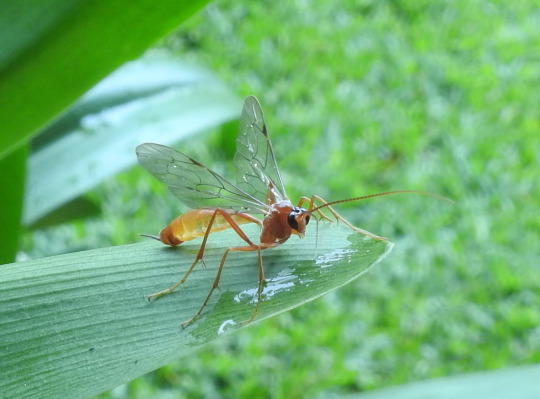
Meet Netelia. This is a genus of Ichneumon wasp. Notice her ovipositor? Kinda short, huh? That’s because it’s a stinger [link]. She stings the caterpillar, which is paralyzed long enough for her to beadazzle it with eggs, and off she goes. I don’t know much about the evolutionary history of ovipositors and stingers, but somehow, some species started living in large colonies full of sterile female workers and a stingless queen who laid all the eggs (think ants and bees). If you didn’t reproduce, you could make some pretty scary and painful stingers to protect your colony! Also: this means that only females can sting.
And this brings us to the issue: some of them DO sting humans and it is not pleasant!
Bees and wasps are similar in that the notorious species tend to live in large colonies, but they sting for very different reasons. Bees are defensive (their stingers are embedded into flesh and detach from their bodies–a nice way of saying they rip their guts out and die), while wasps are offensive (they can sting many, many times, and will do it when they feel threatened even if they are not under attack).

Left: Western Honey Bee; Right: Apache Wasp
Why are they so different? Bees are vegetarians, so they have no need to kill for food. Their stingers are the last line of defense for their colonies, because every bee who stings will die. A colony can’t survive if all the workers die, but it also needs to protect the young and the queen. But these bees tend to make fairly elaborate hives which serve as a good line of defense in addition to the army of stinging workers. Bees will sting if you are actively harming them or the hive, even if you don’t realize it. Remember those ridiculous wide leg raver pants (hey, I said I graduated from college in 2005, stop looking at me like that)? I knew a guy who wore those all the time, and one day his pant leg managed to fall over a single lady bee, and she… uh… Well, she felt threatened. Let’s just say I laughed. Yes, as it happened. I regret nothing. Bees do not want to sting you.
Wasps are also vegetarians (wait, WHAT??)–at least, they are in adulthood. Wasp larvae? Carnivores. Those evil wasps killing other bugs and carrying them off are taking them to their nest. They will lay an egg alongside their prey, which is paralyzed to keep it alive until the egg hatches (terrifying, huh?). What a good mother! Some wasp species are solitary, and their nests can be safe underground. But paper wasps, which you are likely more familiar with, have their babies literally hanging out in the open. Their delicious, nutritious babies. They are so vulnerable! They must be protected!
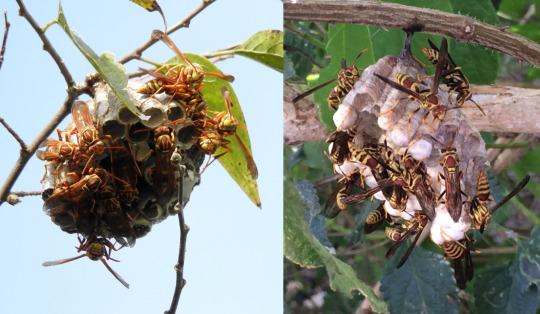
Paper wasps. Left: Apache wasp nest; Right: Common paper wasp nest
The only thing between a hungry predator and the life of those babies are the valiant wasps sworn to protect the nest. If they sense something which triggers the “hungry predator” switch in their brain, they will attack. Is their nest pretty low to the ground? Are you TOO CLOSE? Look out! Is their nest HIDDEN IN YOUR BALCONY WALL and you bump the side while enjoying a beautiful spring day? Are you throwing rocks at the nest? Do you smell like a bear? I don’t know what triggers wasps, but the only time I’ve been stung was when they secretly lived in my balcony wall. Thing with wasps is, when they’ve had enough, they will come after you. They can sting you to teach you to STAY AWAY and fly back to their nest.

But, if you don’t set off “hungry predator” alarms, and instead exist in their world as “irrelevant scavenger,” you can actually get pretty close to them. I was lucky to find this Common Paper Wasp lady making her nest on the underside of a pokeweed leaf in my backyard two years ago. I took these photos with my phone. I was inches away from her. Sometimes I had a headlamp shining in her face. She never once came after me. I started to recognize her foraging around my yard for paper fiber (ever see a wasp hanging out on your wooden fence, or landing on grass or dried dead plants? they are collecting building materials!), so I could get a really close look at her nest and the eggs inside. Look in the cells in the nest in the top left and bottom right photos. Those little white things are her eggs!
So there’s a bit of a Catch-22 here. If you’re not afraid of wasps, come up to them curiously, SHOVE A CELL PHONE IN THEIR FACE WHILE BLINDING THEM WITH A HEADLAMP, eh, they don’t care. But if you are afraid of getting stung… what are you going to do? Calmly walk away? NO! You’re going to swat at it, flail around, run, scream, etc. All things a predator would do. Same thing with bees. Sometimes, they will land on you for whatever reason. Maybe you’re wearing a fluorescent yellow shirt and you look delicious.

All this baby wanted was some nectar, and from her perspective, I was *clearly* advertising that I had bountiful nectar reserves. If I was not aware that they see UV light, and that this is how they find flowers so quickly, and if I instead thought that bees hate the color yellow and will sting you if you’re wearing it (this is what I was taught growing up… *sigh*), I would have thought I was getting attacked, and would have started with the flailing. This lady, who thought she was coming for lunch, instead now has to start fighting? She’s gonna be mad.
There is a lot to know about bees and wasps. I do not know that much about them, but I think they are very interesting and I love learning more about them.
Mimics Can’t Fool You!
Wow that first section was long. How about some pictures of things that aren’t bees or wasps?

Hover flies! Top: Left - Eupeodes sp.; Right - Copestylum sp. Bottom: Left - Palpada agrorum; Right - Yellow-shouldered Drone Fly
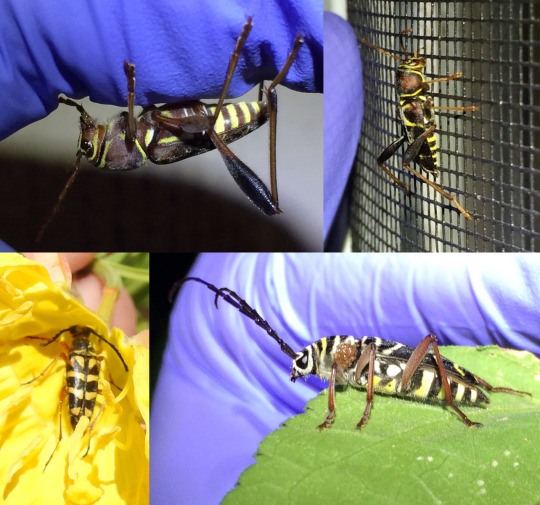
Longhorn beetles! Top: Neoclytus mucronatus (both photos) Bottom: Left - Zebra Longhorn Beetle; Right - Painted Hickory Borer
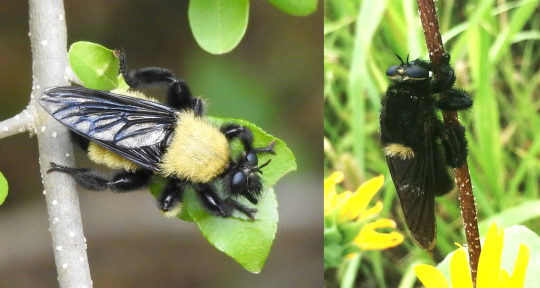
Robber flies! Left: MacQuart’s Bee-mimic Robber Fly; Right: Beelzebub Bee-Killer

Moths! Left: Sphinx moths; Right: Clear-wing mothsI know, I’m cheating a little here. These are specimens in the Texas A&M University Entomology Collections. They have an open house every January and it’s AMAZING!

Bee flies! (really!) Left: Poecilanthrax sp.; Middle: Exoprosopa fascipennis; Right: Villa sp.
Some clear take-aways here: (1) Flies are very into bees(2) Looking like a bee/wasp is a very successful survival strategy!(3) If it looks like a bee… it’s probably a fly (unless it’s actually a bee)
Stingless Fakers
There are two major groups of bees that don’t sting–Tribe Meliponini (Stingless Bees) and Family Andrenidae (Mining Bees).

Admittedly, I have not seen many of these. The two Meliponini species I saw were in Malawi (Africa), and those are the two photos on the left. Far left is a group going to their hive (they can make honey, too!), and center is a different species in their nest (a wax tube on the side of my cottage). These bees are so tiny you’d think they were fruit flies! Right photo is from West Texas, Mining Bees in the Macrotera genus (I love them! Little Valentine butts!)
BUT! There is another fairly common group of stingless bees: MALES. No male insect can sting (they can bite if equipped, but remember, stingers are modified ovipositors!). You may never see a male honey bee, but here’s what they look like:
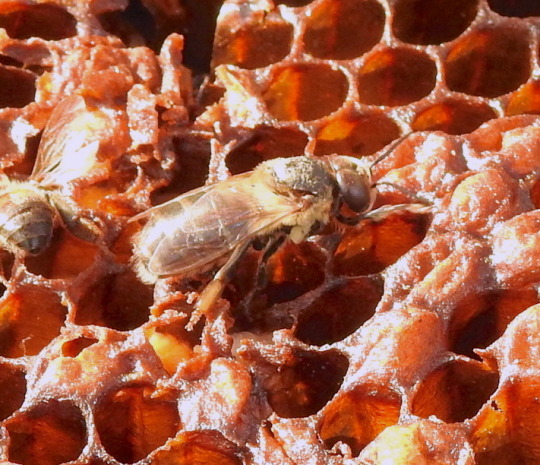
Not the best photo, but you can see he’s shaped… kinda weird? His eyes are HUGE, which is probably the easiest way to tell him apart from the females.
You are more likely to meet a male Carpenter bee, however. How will you know a male carpenter bee?
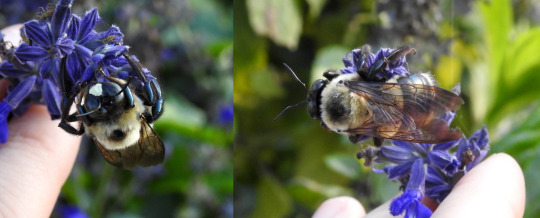
Male Eastern Carpenter Bee above. I read the males have a white patch on their face (look! his nose!), and there were some other features, but really, WHITE! NOSE!
Another Carpenter Bee I see at home (and NOTICE because … well you’ll see in a minute):

Xylocopa tabaniformis Carpenter Bee. Many apologies for the TERRIBLE PHOTOS. These were from my phone before I had a Real Camera and they only *just came back* this year and I am way behind on photos sorrryyyyyyyy
Anyway, I don’t know how to tell the females/males apart visually (or if you even can). And this photo may very well be of a female, who knows. But the way you know the males: They will get in your business. That’s why I call this section “Stingless Fakers.” It’s because of these. I love them. This pink bush is right outside my front door. I walk around it to get to my car in the morning. And in the summers, there are always a few of these buzzing around. And the males are interested in protecting their (small underground) colonies, so they will COME UP TO YOU to see if you’re a threat. Or maybe to intimidate you because THEY ARE A BEE THEY COULD STING LOOK OUT!
Carpenter bees are distinguished from bumble bees by not being as furry. Carpenter bees will have shiny abdomens. Bumble Bees should be bumbly furry.
ANYWAY IN CONCLUSION Bees/Wasps are interesting, not everything is a bee/wasp even if it looks like one, and they don’t all sting. I wish you the best of luck in facing your fears and buzzing back at bees and hornets in triumph.
Posted (finally–sorry!) May 31, 2018As always, all photos are mine and most were taken in Texas. Exceptions are Netelia and Meliponini from Malawi.
#asks#informational#educational#entomology#hymenoptera#bees#wasps#mimics#fakers#phobias#psychology#infodump#wall of text#td;dr#flies#diptera#beetles#bugblr#insects#beeblr#i stayed at work way too late writing this haaaaaaaaaaaa#finger for scale#ovipositors#hot ovipositor action#stingers#bee stings#wasp stings
722 notes
·
View notes
Photo

Ichneumonid and Braconid Wasps. The subfamily Ichneumonoidea contains the two largest families within Hymenoptera: Ichneumonidae and Braconidae. The group is thought to contain as many as 100,000 species, many of which have not yet been described. Like other parasitoid wasps, they were long placed in the "Parasitica", variously considered as an infraorder or an unranked clade, now known to be paraphyletic. (at Arlington, Virginia) https://www.instagram.com/p/Cbyo8eOsMKWp-v5ra1lufRhz0PS_tcL8euqkxY0/?utm_medium=tumblr
0 notes
Text
Новости высоких технологий | В США найдены новые виды ос, способных превращать своих жертв в зомби
Новости высоких технологий | В США найдены новые виды ос, способных превращать своих жертв в зомби
В первой половине 2019 года мы рассказывали про существование паразитических ос, которые способны превращать тропических пауков в «зомби» и использовать их тела для создания прочных убежищ из паутины. Этими паразитическими созданиями являются так называемые ихневмоноидные наездники (Ichneumonoidea) и эта группа насекомых считается одной из самых обширных в мире. По расчетам ученых, она включает…
View On WordPress
0 notes

